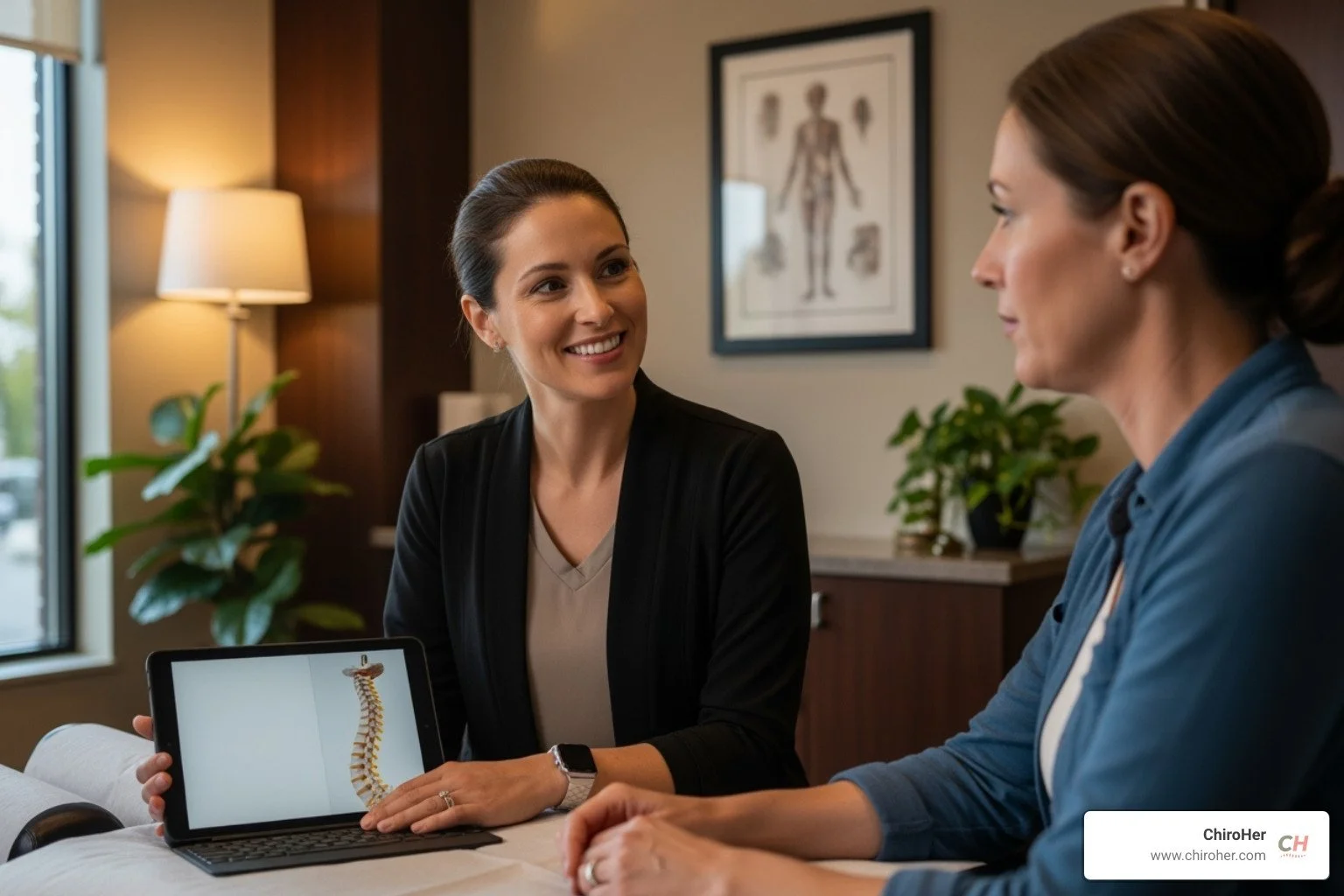Beyond the Ache: Connecting with Your Ideal Back Specialist
Why Finding the Right Back Specialist Matters
Searching for a "back specialist near me" is a common step for those with persistent pain. You're not alone; research shows that 76 percent of Americans experience acute back pain. In fact, low back pain is a leading reason for doctor visits in the U.S.
Relief is possible when you connect with the right professional. The challenge is knowing where to start.
How to Find a Back Specialist Near You:
Identify your pain type: Is it acute (sudden) or chronic (over 6 weeks)?
Choose the right specialist: Options include chiropractors, physiatrists, and pain management doctors.
Check credentials and reviews: Look for board certification and patient feedback.
Schedule a consultation: See if the specialist is the right fit for you.
Prepare your medical history: Bring imaging results, medication lists, and a symptom timeline.
Hi! I'm Dr. Michelle Andrews, founder of ChiroHer in Oklahoma City. I've helped hundreds of patients steer the process of finding a back specialist near me for their unique needs, from sports injuries to chronic pain. My goal is to help you understand your options and make confident decisions about your care.
Your Guide to Finding a Back Specialist Near Me
When back pain disrupts your life, the first question is, "Who can help?" Understanding what each specialist does can save you time and lead you to the right path for relief.
Who to See: Understanding Different Types of Back Specialists
Choosing the right professional depends on your pain and treatment goals.
Chiropractors focus on diagnosing and treating neuromuscular disorders through manual adjustment of the spine. We aim to restore proper nervous system function to reduce pain and improve health, often addressing low back pain, sciatica, and herniated discs. Learn more about what does a chiropractor do and the benefits of chiropractic care.
Physiatrists (Physical Medicine and Rehabilitation physicians) specialize in restoring function after an injury or disability. They use non-surgical treatments like physical therapy and targeted injections.
Pain Management Providers are often anesthesiologists or physiatrists who treat chronic pain with nerve blocks, epidural injections, and other advanced therapies.
Rheumatologists treat inflammatory conditions affecting joints and muscles, such as ankylosing spondylitis or rheumatoid arthritis.
Orthopedic surgeons manage musculoskeletal conditions. While they perform surgery, most prioritize conservative care first for issues like severe herniated discs, spinal stenosis, or fractures.
When to Escalate Care: GP vs. Specialist
Your general practitioner (GP) is a good first stop for mild, acute back pain. However, it's time to see a specialist if:
Your pain lasts more than six weeks.
You experience red flag symptoms, such as sudden severe pain after an injury, numbness or weakness in your limbs, or loss of bowel/bladder control (a medical emergency).
Pain is accompanied by unexplained weight loss or fever.
Pain from an accident or back injury doesn't improve.
Conservative care from your GP hasn't worked.
How to Find the Right Back Specialist Near Me
Finding the right specialist can feel overwhelming, but these steps can help.
Search online for "back specialist" or "chiropractor" in your city. Look for informative websites that explain their philosophy and services.
Verify credentials like state licenses and board certifications to ensure they have the right expertise.
Read patient reviews to get insights into the specialist's approach and effectiveness.
Ask for personal referrals from your GP, family, or friends.
Get a second opinion if you're unsure about a diagnosis or treatment plan.
Prepare for your appointment by bringing your medical history, imaging reports, and a list of questions. For more guidance, see our find a chiropractor complete guide or schedule consultation with us online.
At ChiroHer, we serve the Oklahoma City area, including Yukon, Edmond, Nichols Hills, Del City, Mustang, and Moore. We're here to help you find relief.
Understanding the Path to Recovery
Once you've found a specialist, the next step is figuring out the cause of your pain and the best way to treat it.
The First Step: Diagnosis and Your Initial Appointment
Your first visit is a fact-finding mission. Expect to discuss your:
Medical history: We'll review when the pain started, what makes it worse, and your general health.
Physical examination: We will check your posture, movement, and feel along your spine for tenderness or muscle tightness. Range of motion tests help us see how your spine is functioning.
Neurological screening: We test reflexes, muscle strength, and sensation to see if nerves are affected.
Diagnostic imaging: Depending on the findings, we may recommend X-rays to see bones, an MRI for soft tissues like discs and nerves, or a CT scan for detailed bone structures. The goal is an accurate diagnosis to create an effective treatment plan.
A Spectrum of Solutions: From Conservative Care to Surgery
Most back pain responds well to non-surgical treatments. We always start with the least invasive options.
Physical therapy strengthens core muscles, improves flexibility, and teaches you how to move safely to prevent future injuries.
Chiropractic adjustments are designed to restore proper movement to spinal joints, which may help reduce nerve pressure and support the body's natural healing process. Many patients report feeling relief after treatment. Learn more about How Does Chiropractic Treatment Help in Alleviating Back Pain. Our guide to Natural Back Pain Relief offers complementary strategies.
Interventional pain management uses targeted procedures like epidural steroid injections or nerve blocks to reduce inflammation and block pain signals at the source.
Regenerative medicine is an emerging field using your body's own healing factors, like platelet-rich plasma, to repair damaged tissues.
For conditions like sciatica and herniated discs, conservative care is often very effective. Chiropractic adjustments and spinal decompression are techniques that may help relieve nerve pressure and support disc health. Our Low Back Pain Relief Guide covers these conditions.
Surgery is a last resort, considered only when conservative treatments fail or if there are signs of progressive nerve damage.
Managing Your Care: Chronic Pain, Costs, and Next Steps
Managing chronic pain (lasting over three months) focuses on reducing pain and improving your quality of life. This often involves a team approach with regular chiropractic care, physical therapy, and lifestyle changes.
Your daily habits, such as good posture, regular movement, and an ergonomic workspace, play a large role in back health. We provide home exercises and techniques to help you manage pain between visits.
The cost of care varies based on the provider, treatments, and your insurance. Many plans cover chiropractic care and physical therapy. We work with major insurance companies and can help you understand your benefits.
If you're in the Oklahoma City area, we'd love to meet you. At ChiroHer, we offer personalized care in a comfortable setting. Learn more about our approach in Oklahoma City, or Contact Us Oklahoma City to schedule your visit.
Building Trust: Authority and Resources
When searching for a back specialist, trust is key. You deserve care that is both compassionate and rooted in solid science.
Evidence-based care means your treatments are backed by research. At ChiroHer, we stay updated on the latest studies in chiropractic care and holistic wellness to ensure our recommendations are effective.
You should always feel comfortable verifying a provider's credentials. Ask about their education, certifications, and experience. For chiropractors, you can check with your state's licensing board. Look for providers who are members of professional organizations and pursue ongoing education.
To help you stay informed, we recommend these trusted resources:
The National Institute of Neurological Disorders and Stroke offers a comprehensive NIH Back Pain Overview.
The American Chiropractic Association provides evidence-based information on spinal health at American Chiropractic Association.
The more you understand your condition and your provider's credentials, the more confident you will be in your care. We are here to partner with you, providing transparent, research-backed treatment.
This guide is for informational purposes and is not a substitute for already established medical advice from your healthcare provider.





